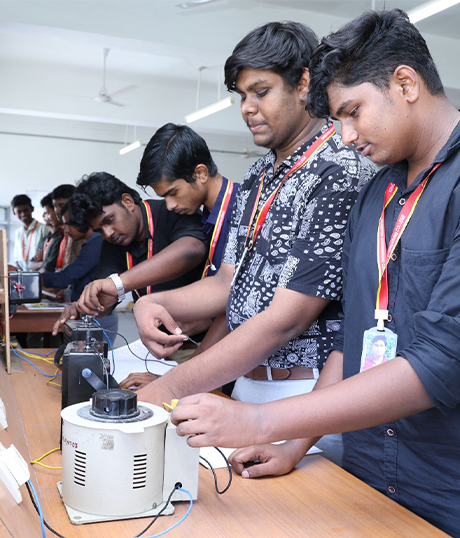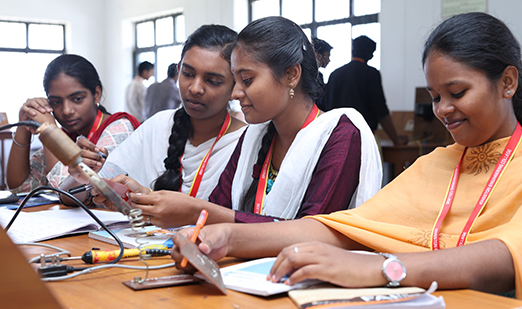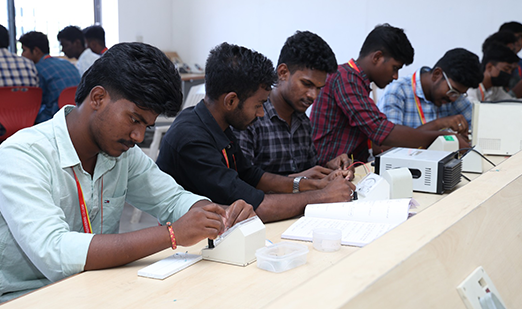Electronics and Communication Engineering
Department Introduction
The Department has fully equipped state-of-the-art laboratories and highly qualified and dedicated faculty with international reputation. The department functions with efficient faculty and well equipped lab facilities. It has conducted many technical symposium and workshops. Extensive laboratory facilities for various labs including VLSI, Communication, Networking, DSP& Signal processing, Microprocessors etc. are available.

Objectives
To establish our department as a premiere center of educational excellence by providing a student-centered learning environment that is committed to changing the destinies of ordinary and disenfranchised persons so they can become extraordinary citizen leaders in their communities and the world.
Our department seeks to educate the whole person, and the great deal of learning takes place outside of the traditional classroom. Student life at our department is defined the mixture and balance of academic rigor, co-curricular and extracurricular pursuits, and service to others.

Vision Of The Department
- To develop the department into a full-fledged centre for learning in recent trends of Electronics and Communication Engineering and thereby enabling our graduates to excel as efficient engineer, manager or entrepreneur.

Mission Of The Department
- Providing quality education in the areas of Electronics and communication engineering to enhance the competitiveness of our graduates in the job market and contribute to the economic, scientific and social developments.
- Endowing students with the knowledge, technical skills and values that prepare them to excel as engineers and leaders in their profession and to be committed to lifelong learning.
/B.E. Electronics and Communication Engineering
- To provide the students with a strong foundation in the required sciences in order to pursue studies in Electronics and Communication Engineering.
- To gain adequate knowledge to become a good professional in electronic and communication engineering associated industries, higher education, and research.
- To develop an attitude in lifelong learning, applying and adapting new ideas and technologies as their field evolves.
- To prepare students to critically analyze existing literature in an area of specialization and ethically develop innovative and research-oriented methodologies to solve the problems identified.
- To inculcate in the students a professional and ethical attitude and an ability to visualize the engineering issues in a broader social context.
- Engineering knowledge: Apply the knowledge of mathematics, science, engineering fundamentals, and an engineering specialization to the solution of complex engineering problems.
- Problem analysis: Identify, formulate, review research literature, and analyse complex engineering problems reaching substantiated conclusions using first principles of mathematics, natural sciences, and engineering sciences.
- Design/development of solutions: Design solutions for complex engineering problems and design system components or processes that meet the specified needs with appropriate consideration for the public health and safety, and the cultural, societal, and environmental considerations.
- Conduct investigations of complex problems: Use research-based knowledge and research methods including design of experiments, analysis and interpretation of data, and synthesis of the information to provide valid conclusions.
- Modern tool usage: Create, select, and apply appropriate techniques, resources, and modern engineering and IT tools including prediction and modeling to complex engineering activities with an understanding of the limitations.
- The engineer and society: Apply reasoning informed by the contextual knowledge to assess societal, health, safety, legal and cultural issues and the consequent responsibilities relevant to the professional engineering practice.
- Environment and sustainability: Understand the impact of the professional engineering solutions in societal and environmental contexts, and demonstrate the knowledge of, and need for sustainable development.
- Ethics: Apply ethical principles and commit to professional ethics and responsibilities and norms of the engineering practice.
- Individual and team work: Function effectively as an individual, and as a member or leader in diverse teams, and in multidisciplinary settings.
- Communication: Communicate effectively on complex engineering activities with the engineering community and with society at large, such as, being able to comprehend and write effective reports and design documentation, make effective presentations, and give and receive clear instructions.
- Project management and finance: Demonstrate knowledge and understanding of the engineering and management principles and apply these to one’s own work, as a member and leader in a team, to manage projects and in multidisciplinary environments.
- Life-long learning: Recognize the need for, and have the preparation and ability to engage in independent and life-long learning in the broadest context of technological change.
- PSO1: Design, develop and analyze electronic systems through application of relevant electronics, mathematics and engineering principles.
- PSO2: Design, develop and analyze communication systems through application of fundamentals from communication principles, signal processing, and RF System Design & Electromagnetics.
- PSO3: Adapt to emerging electronics and communication technologies and develop innovative solutions for existing and newer problems.
| S.No | Name of the Laboratory | Name of the Important equipment |
|---|---|---|
| 1 | Electronics Laboratory | Transistor BC 107, BC 547, BC 548, UJT 2N2646, FET BFW10, 1N4007, Zener diodes, Resistors, Capacitors, Inductors, Bread boards, CRO (30MHz), Function Generators (2 MHz) and (3 MHz), Dual Regulated Power Supplies (0 – 30V), Digital Multimeter, Digital LCR Meter, Standalone desktops PC, Transformers, P-SPICE Software, Components and Accessories |
| 2 | Linear Integrated Circuit and Digital Laboratory | CRO (30MHz), Signal Generator / Function Generators (2 MHz), and (3 MHz), Dual Regulated Power Supplies (0 – 30V), Standalone desktop PCs with P-SPICE software, Transistor 2N3391 and FET, Dual power supply/ single mode power supply, IC Trainer Kit, IC tester, Bread boards, Computer with Xilinx ISE software, Seven segment display, ICs 7400, 7402, 7404, 7486, 7408, 7432, 7483, 74150, 74151, 74147, 7445, 7476, 7491, 7494, 7447, 74180, 7485, 7411, 7474, Op-Amps uA741, LM 324, LM317, LM723, 7805, 7812, 2N3524, 2N3525, SG3524, SG3525 LM 555, LM 565, Digital Multimeter, Resistors, Capacitors, Diodes, Zener diodes, Step-down Transformer, wires, Power Transistor SL100, SK100, Potentiometer, A/D and D/A convertor, LEDs, Components and Accessories. |
| 3 | Communication Laboratory | Kits for Signal Sampling, TDM, AM, FM, PCM, DM and Line Coding Schemes, MATLAB and PCs, Function generators, Power supply, CRO, Bread boards. |
| 4 | Microprocessor and Microcontroller Laboratory | 8085 and 8086 Microprocessor trainer kit, 8051 Microcontroller trainer kit, Interfacing Units 8255, 8251, 8259, 8279, 8254 timer counter, ADC and DAC card, DC motor with Controller, Traffic light control system, Stepper motor control, Digital clock, Printer, Intel desktop systems with MASM. |
| 5 | VLSI Design Laboratory / DSP Laboratory | Xilinx FPGA Spartan III XC3S400 PQ208 -4C, PCs with Xilinx and Tanner EDA software package, Fixed / Floating point DSP processor kit TMS320C6713, MATLAB with Simulink and Signal Processing Tool Box in desktop systems, Signal generators (1MHz) and CRO (20MHz). |
| 6 | Computer Networks Laboratory / Embedded Laboratory | C / C++ / Java Compiler, desktops with NS2 Network simulator and ARM 7 processor development kit. |
| 7 | Optical and Microwave Laboratory | Trainer kit for carrying out LED and PIN diode characteristics, Digital multi meter, optical power Meter, Trainer kit for determining the mode characteristics, losses in optical fiber, Trainer kit for analyzing Analog and Digital link performance, 2 Mbps PRBS Data source, 10 MHz signal generator, 20 MHz Digital storage Oscilloscope, Kit for measuring Numerical aperture and Attenuation of fiber, MM/SM Glass and plastic fiber patch chords with ST / SC / E2000 connectors, LEDs with ST / SC / E2000 receptacles – 650 / 850 nm, PiN PDs with ST / SC / E2000 receptacles – 650 / 850 nm, Microwave test Bench at X band to determine Directional coupler characteristics, Microwave test Bench at X band and Antenna turn table to measure Radiation pattern of Horn antenna, 2 Horn antennas, Microwave test Bench at X band to determine VSWR for Isolator and Circulator, VSWR meter, Isolator, Circulator, E Plane Tee, H plane Tee, Microwave test Bench at X band, Variable attenuator, Detector, 20 MHz Analog oscilloscope. |
Facilities in Project Laboratory
| S.No | Name of the facilities | Specification |
|---|---|---|
| 1 | General purpose PCB | Size: (4*4) and (6*4) |
| 2 | Soldering flux | White Colour |
| 3 | Soldering lead | Soldering lead |
| 4 | Soldering iron | Soldron make 25Watts |
| 5 | Bread board | 840 Contact points and Size: 174mm (6.9") x 67mm (2.4") |
| 6 | Resistor | 10Ω, 100Ω, 150Ω, 220Ω, 470Ω, 560Ω, 680Ω, 1KΩ, 1.2KΩ, 1.5KΩ, 1.8KΩ, 2KΩ, 2.2KΩ, 3.3KΩ, 4.7KΩ, 6.8KΩ, 8.2KΩ, 10KΩ, 15KΩ, 22KΩ, 33KΩ, 47KΩ, 100KΩ, 1MΩ and Decade resistance box |
| 7 | Capacitor | 0.001µF, 0.01µF, 0.1µF, 1μF, 10µF, 100µF, 220µF, 470µF, 1000µF and Decade capacitance box |
| 8 | Inductor | Decade inductance box |
| 9 | Transformer | 0-9, 9-0-9, 12-0-12 and 15-0-15 |
| 10 | Diode | 1N4007, Zener diode, LED, PIN diode |
| 11 | Transistor / FET (BJT-NPN-PNP and NMOS / PMOS) | BC 107, BC 148, 2N2646, BFW10, SL100 and SK100 |
| 12 | ICs | 7402, 7404, 7486, 7408, 7432, 7483, 74150, 74151, 74147, 7445, 7476, 7491, 555, 7494, 7447, 74180, 7485, 7473, 74138, 7411, 7474, Op-Amps uA741, LM 301, LM311, LM 324, LM317, LM723, 7805, 7812, 2N3524, 2N3525, 2N3391, AD 633, LM 555 and LM 565 |
| 13 | Seven segment display | |
| 14 | Dual regulated power supplies | (0 – 30V) |
| 15 | Signal generator / Function generator | 1 MHz, 2 MHz and 3MHz |
| 16 | Digital and Analog oscilloscope | 20 MHz and 30 MHz |
| 17 | Digital Multimeter / Digital LCR Meter | |
| 18 | Standalone desktops PC | Microsoft Windows OS and Intel processors |
| 19 | Software | P-SPICE, MATLAB, MASM, XILINX, Tanner EDA, Micro wind 2.7, C, C++, Java HFSS,Optsim,Commsim,Keil software,MASM,Proteus design,Pspice,Mentor Graphics,Microwind,gnucap and NS2 |
| 20 | Hardware | 8085 processor kit, 8086 processor kit, 8051 controller kit, Xilinx FPGA Kit, DSP processors kit, A/D and D/A interfacing kit, Keyboard display interface kit, Stepper motor interface kit, DC motor interface, Serial and parallel interface |
| 21 | IC tester | |
| 22 | Patch chord | |
| 23 | Cutting pliers | |
| 24 | Wire cutter | |
| 25 | Connecting wires |
Grants
| S.No | Name of the faculty | Project Title | Project Type Research/Consultancy | Funding Agency | Amount | Status |
|---|---|---|---|---|---|---|
| 1 | Dr.T.Senthil Kumar | MODROBS | Research | AICTE | 15,00,000 | Evaluation Completed |
| 2 | Dr.S.Vishnu Priyan | STTP | Training Program (AQIS Scheme) | AICTE | 375000 | Evaluation Completed |
Patents
| S.No | Applicant Name | Inventor Name | Title of the Patent | Application Number | Date |
|---|---|---|---|---|---|
| 1 | Dr.S.Vishnu Priyan | Dr.S.Vishnu Priyan | Clogging Control and Prevention in Routing in WSN | 201941019143 A | 14/06/2019 |
| 2 | Mr.A.Jothi Murugan | Dr.T.Senthil Kumar Dr.S.Vishnupriyan Ms.L.Mohanasundari Mr.K.P.Senthilkumar Mr.T.Prasath Mr.C.Sureshkumar Mr.A.Jothi Murugan | Vehicle Display Unit Control System and a Method Therefor | 201941023453 A | 21/06/2019 |
Mou's
| 1 | MoU with HCL Career Development Centre, Chennai- Imparting Value Added Services by providing Training to students and Faculty Members. |
| 2 | MoU with Airtel (Milky Way Cell Tech), Chennai – Imparting Value Added Services by providing Training to students and Faculty Members. |




